RBA Governor Lowe set out his views in Brisbane. What hope the budget surplus then?
I would like to begin by providing an update on recent developments in the global and Australian economies. I will then discuss how our thinking on the appropriate stance of monetary policy has evolved over recent times.
The Global Picture
Up until around the middle of last year, the global economy was growing quite briskly (Graph 1). Then, over the second half of the year, growth slowed and this lower pace continued into 2019.
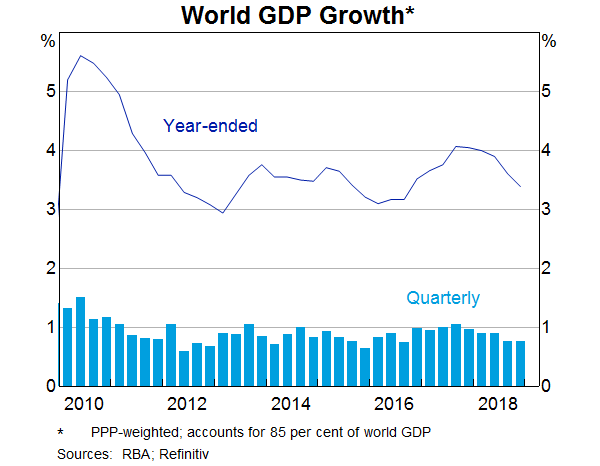
There are a few factors that help explain this slowing in the global economy.
The first is a slowdown in the Chinese economy. The Chinese authorities have for some time been seeking to address the build-up of risks in the financial system. As part of their efforts on this front they have sought to rein in shadow banking. The effect of this has been felt across their economy and, given the size of the Chinese economy, the impact has also been felt around the world.
A second factor is a marked slowdown in international trade. Over the past year, global trade has not grown at all (Graph 2). This is unusual as, historically, global trade has tended to increase at least as fast as GDP. This recent weakness partly reflects the slowing in the Chinese economy, but the increases in US and Chinese tariffs are also a factor. Not surprisingly, it has flowed through into weaker conditions in the manufacturing sector around the world and there has been a disruption to some supply chains. Business investment, too, has been affected, with firms delaying investment decisions. In the face of increased uncertainty about future trade policy, many businesses have preferred to wait for a clearer picture. A cyclical downturn in the global electronics industry has also weighed on exports and investment, particularly in some east Asian economies.
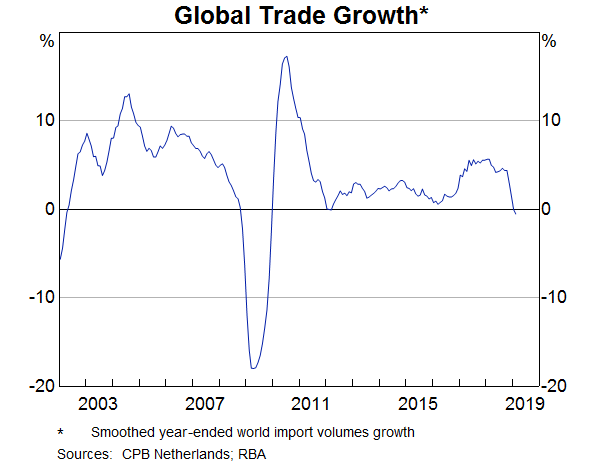
A third factor contributing to the slowdown in global growth has been a series of country-specific factors, including natural disasters in Japan, a new vehicle emissions testing regime in Germany and some extreme weather events.
So, these are some of the key factors that have been at work.
Looking forward, the global picture looks a little brighter and it is reasonable to expect that growth will strengthen a little later in the year.
The Chinese authorities have responded to the slowing in their economy with measures to support economic activity. Globally, financial conditions are very accommodative and major central banks have signalled an easier monetary policy stance than was earlier expected. It is also reasonable to expect that the drag on growth from some of the country-specific factors that I mentioned will pass in time. Consumption growth in many economies also remains robust, supported by strong employment growth and rising wages. And notably, the weakness in the manufacturing sector has not spilled over in a material way to the services sector. All this means that the global economy appears quite resilient at the moment.
The big uncertainty remains trade policy. A resolution of the current disputes would help boost trade flows and reduce some of the uncertainties facing businesses. In that case, we could expect a pick-up in investment too. On the other hand, a failure to resolve the disputes represents a major downside risk to the global economy. So there is a lot riding on this issue.
One other feature of the global economy that I would like to draw your attention to is the coexistence of low unemployment and low inflation. Unemployment rates in many of the major economies are the lowest they have been in many decades. At the same time, inflation remains low. While wages growth has picked up, inflation rates are mostly below 2 per cent and below the central banks’ targets (Graph 3).
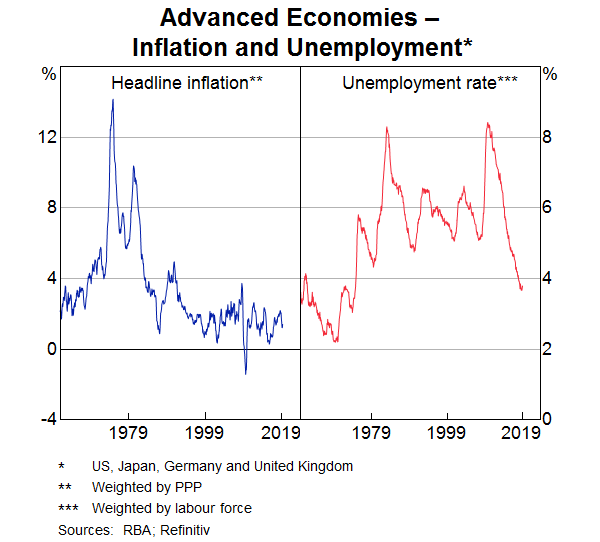
This experience is the opposite to that of the 1970s and early 1980s. During that period, many countries experienced what became known as stagflation: the coexistence of high unemployment and high inflation. Today, the picture is very different: we have low unemployment and low inflation. This is obviously a much better configuration.
Understanding why this has happened is a priority for us, as we too in Australia are experiencing something similar. We are still searching for the full answers, but the fact that the experience is common across so many countries suggests that there are some global factors at work. In my view, these are partly linked to changes in technology and to globalisation. Both of these affect perceptions of competition and they both are a source of uncertainty about the future. In turn, they are affecting pricing decisions across the world.
We can’t be sure how long these effects will last and whether the coexistence of low inflation and low unemployment is temporary, or whether it is a new normal. Whether or not it is permanent, the coexistence of low inflation and low unemployment does appear to be highly persistent. This persistence has led to a reassessment in a number of countries of the unemployment rate that is sustainable without inflation becoming a concern. This is an important issue and one I will return to in the context of Australian monetary policy.
The Australian Economy
I would first like to provide an update on the Australian economy.
Just as the global economy slowed over the second half of 2018, so too did the Australian economy – we went from growing at an above-average pace in the first half of 2018 to a below-average pace in the second half (Graph 4).
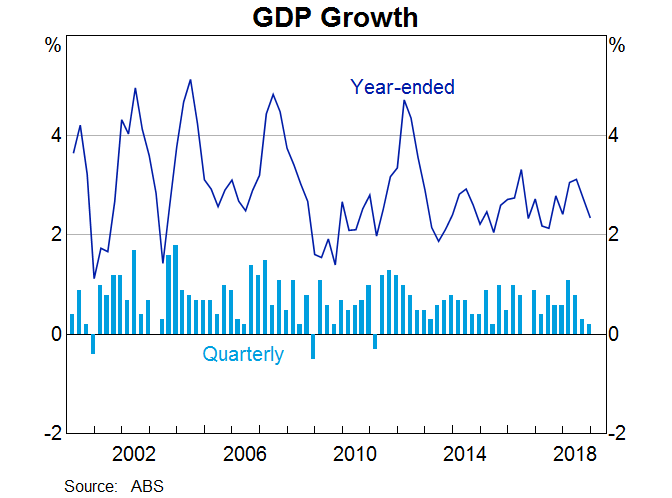
As has been the case globally, we had our own country-specific factors that have temporarily weighed on economic growth, including the drought and some disruptions to resource production and exports.
More fundamentally, though, the main reason for the shift in momentum in the Australian economy is a slowdown in household consumption growth. Over the second half of 2018, household consumption increased by just ¾ per cent, which is an unusually soft outcome.
The decline in housing prices is a factor here, but the more important factor is the long period of weak growth in household income (Graph 5). Over the past three years, household disposable income has increased at an average rate of just 2¾ per cent. This compares with an average of 6 per cent over the preceding decade. As this period of weak income growth has persisted, it has become harder for households to dismiss it as just a temporary development – as something that will pass quickly. The lower rate of income growth has also made it harder for households to pay down debt. The end result has been that many people have decided to adjust their spending plans. There was further evidence of this adjustment in the retail trade data for the March quarter.
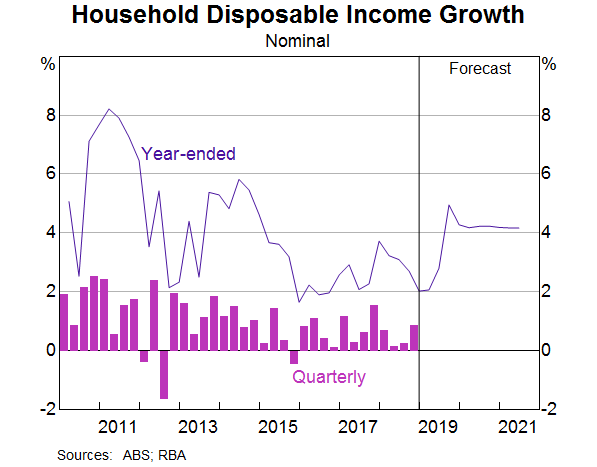
We are not expecting a quick turnaround in growth in consumer spending, but we are expecting a gradual improvement. This is largely on the basis of an expected pick-up in growth in household income, and a stabilisation of the housing market over the period ahead. We are expecting household disposable income to grow at an average rate of 4 per cent over the next couple of years, which is noticeably higher than the average of recent times. Stronger growth in income will help, but the more important factor is some tax relief.
Over the past year, tax paid by households increased at a much faster rate than did income; almost 10 per cent, compared with 3¼ per cent – that is a big difference and it is unusual. We are not expecting it to continue for a couple of reasons. First, the tax offsets for low- and middle-income earners announced in the recent budget will boost disposable income. And second, it is likely that we will return to a more normal relationship between growth in incomes and tax paid.
Our expectation is that the stronger growth in disposable income will flow through into household spending, although this will take some time.
Looking beyond household spending, the outlook for the Australian economy is being supported by a number of other developments.
The first is the ongoing investment in infrastructure. This investment is important. It is not only supporting demand in the economy at a time when this is needed, but it is also adding to the supply capacity of the economy and directly improving people’s lives, including through a reduction in transport congestion.
There is also strong growth in demand for a range of services, partly as a result of ongoing strong population growth.
Another factor supporting growth is the recent lift in the terms of trade, which have continued to surprise on the upside, boosting our national income.
The outlook for investment in the resources sector has also improved, due to both higher levels of sustaining capital investment and the commencement of some new projects. After five years of declining mining investment as LNG projects were completed, we are expecting an increase over the coming year (Graph 6). Non-mining business investment is also on an upward trend as firms invest in additional capacity. By contrast, investment in residential construction is likely to be a drag on the economy for the next few years. After six years of strong growth, residential construction is now declining and this is likely to continue for a while yet.
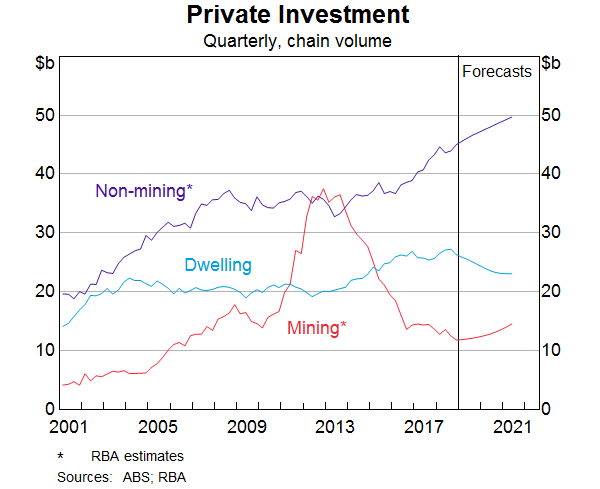
In comparison with the GDP data, the labour market data over the past year have painted a stronger picture of the economy and have mostly surprised on the upside. More people have joined the labour market and job creation has been strong, with employment increasing by 2½ per cent over the year, compared with growth in the working-age population of 1¾ per cent. The unemployment rate has also declined over the past year (Graph 7).
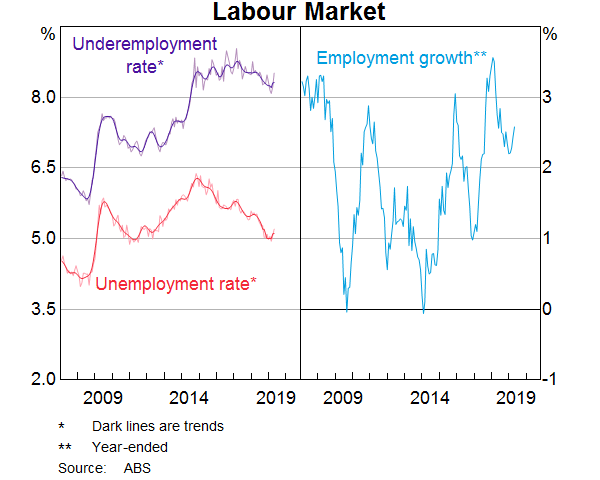
Recently, though, some labour market indicators have softened a little: the unemployment rate ticked up to 5.2 per cent in April; the underemployment rate has also moved a little higher as there are more part-time workers who are seeking additional hours; job advertisements have declined; and hiring intentions have come off their earlier highs. At the same time, the vacancy rate remains high, monthly employment growth remains firm and hiring intentions remain above average. Taking these various indicators together, the labour market continues to be resilient, although our expectation is that employment growth will slow to be broadly in line with growth in the working-age population.
The other element of the labour market that I would like to comment on is wages. As the labour market has strengthened over the past year, wages growth in the private sector has picked up. By contrast, wages growth in the public sector has been steady at around 2½ per cent (Graph 8). Overall, though, wages growth remains lower than the rate that would appear consistent with inflation being comfortably within the target range. Even in New South Wales and Victoria – where the unemployment rates have averaged around 4½ per cent over recent times – wages growth has been running at just 2½ per cent. It would appear that some of the global factors that I mentioned earlier are working here as well.
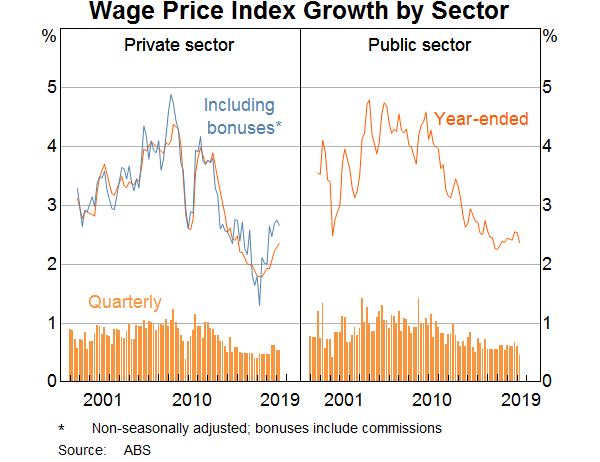
Putting these various elements together, our central scenario – as outlined in our recent Statement on Monetary Policy – is for the Australian economy to grow by 2¾ per cent over both 2019 and 2020 (Graph 9). As always, though, there is a range of uncertainty around this forecast. But the central outlook is for growth at around our estimate of potential growth in the Australian economy. Given this, over these two years the unemployment rate is forecast to be around 5 per cent. In 2021, the central forecast is for slightly better outcomes, partly due to a pick-up in the resources sector.
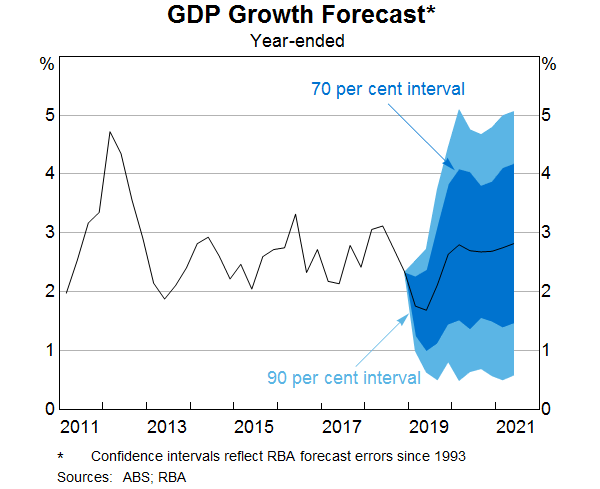
It is worth pointing out that when preparing these forecasts, we used our normal technical assumption that interest rates would move broadly in line with market pricing. At the time the forecasts were prepared, market pricing implied that the cash rate was expected to decline to 1 per cent over the next year. If, instead, we had used an assumption of unchanged interest rates, the growth forecast would have been lower and the forecast for unemployment would have been higher.
Turning now to inflation, the outcome for the March quarter was noticeably lower than we had expected. In year-ended terms, headline inflation was 1.3 per cent and in underlying terms it was around 1½ per cent (Graph 10). Looking through the details of the CPI, there appear to be only limited inflation pressures across much of the economy. The low rates of wages growth are contributing to relatively low rates of inflation in the services sector. Rent inflation is also the lowest it has been in decades. And various government initiatives to ease cost-of-living pressures are contributing to lower increases in many administered prices. Together, these factors have led to a low rate of inflation for non-traded goods and services (Graph 11).
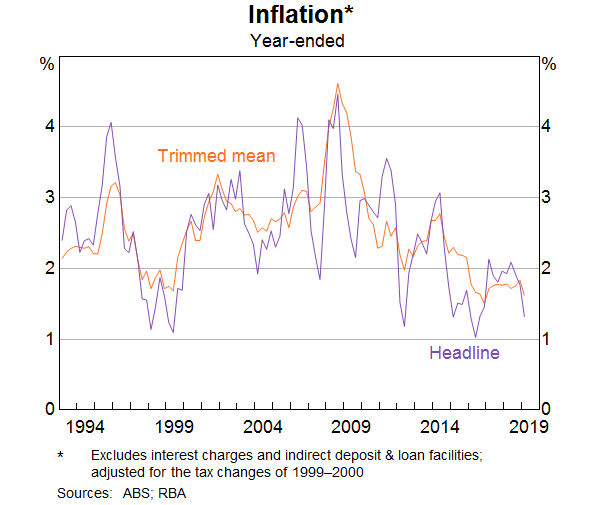
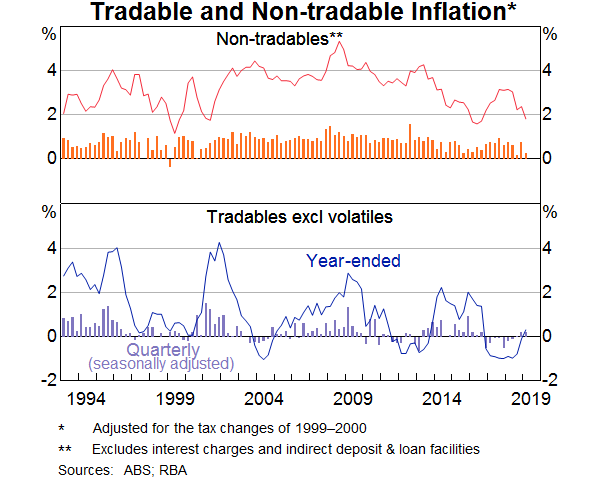
The picture for traded goods and services inflation is a little different. Recently, there have been increases in some food prices as a result of the drought and floods. The earlier small depreciation of the exchange rate has also been passed through into the prices for some consumer durables. These developments mean that tradables prices as a group are no longer declining. Even so, inflation remains low for most traded goods and services.
Looking forward, the central forecast is for underlying inflation of around 1¾ per cent this year, 2 per cent next year and a little higher the following year. In headline terms, inflation is expected to be noticeably higher in the June quarter, due to the recent increase in petrol prices. For 2019 as a whole, headline CPI inflation is expected to be around 2 per cent and the same the following year. This means that inflation is expected to remain around the bottom of the medium-term target range over the forecast period.
Monetary Policy
I would like to turn now to monetary policy and how our thinking and communication have evolved over recent times.
You might recall that through 2018 we had three main messages: (1) we were making progress towards our inflation and unemployment goals; (2) given that this progress was expected to continue, it was more likely that the next move in interest rates would be up, rather than down; and (3) given the progress towards our goals was expected to be only gradual, any move in interest rates was some time off.
Earlier this year, our assessment of the balance of probabilities around the likely direction of the next move in interest rates shifted a little. At the Reserve Bank Board meeting in February, we assessed that the probabilities of an interest rate increase and a decrease had become more evenly balanced than they were through 2018.
This shift reflected two developments.
The first was the slowing in the Australian economy over the second half of 2018 that I just spoke about. And the second was the lower-than-expected inflation outcome for the December quarter. The main countervailing consideration was the labour market, which painted a stronger picture of the economy than the other indicators. In the face of these conflicting signals, we judged that the best approach was to hold interest rates steady while we obtained a clearer picture of the direction of the economy.
It was relatively clear, though, that if the GDP data were giving the better signal – and the labour market eventually softened – lower interest rates would likely be appropriate. This was especially so in light of the ongoing low rate of inflation. This assessment was reflected in the minutes of the Board’s April meeting, where we discussed a scenario in which there was a lack of progress on inflation and the unemployment rate trended higher.
Following our April meeting, we received another reading on inflation, which confirmed that price pressures were subdued across the economy. Over the past year – and particularly in the past two quarters – inflation has come in lower than we expected and our inflation forecasts have been revised down. This is evident in Graph 12, which shows the forecasts a year ago, the actual outcomes and our current forecasts. In contrast to the subdued inflation outcomes, employment growth has been stronger than we expected a year ago. This can be seen in the right-hand panel. In most cases, when employment growth is stronger than expected, we expect to see an upside, not a downside, surprise on inflation. So, from this perspective, the recent experience is a little unusual.
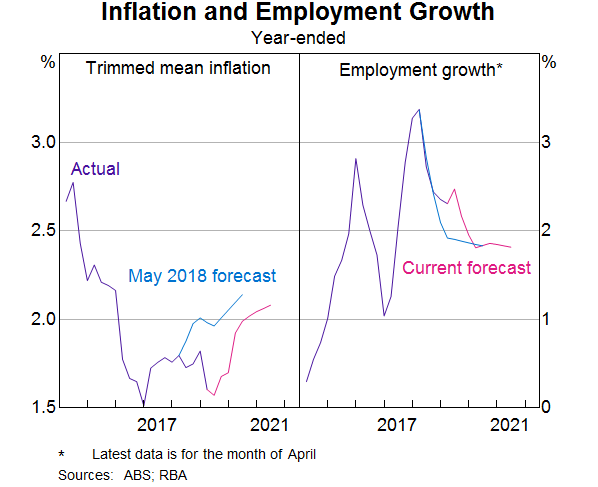
As the Board has sought to understand this experience and studied similar experiences overseas, we have been asking ourselves: what rate of unemployment is achievable in Australia without generating inflation concerns?
Over recent years, the answer to this question was thought to be around 5 per cent – in other words, it was thought that an unemployment rate below 5 per cent was likely to put pressure on the supply capacity of the economy and, in turn, raise possible inflation concerns.
But from today’s perspective, I think we can do better than this. My judgement of the accumulating evidence is that the Australian economy can support an unemployment rate of below 5 per cent without raising inflation concerns. This would be consistent with the experience overseas, with many other advanced economies sustaining lower rates of unemployment than previously thought possible without leading to a noticeable uplift in inflation.
If this judgement is correct, the question is: how does our society achieve and sustain a lower rate of unemployment? It is possible that the current policy settings are sufficient to deliver lower unemployment. The labour market has surprised on the upside over recent times, and it could do so again. While we can’t rule out this possibility, the recent flow of data makes it seem less likely.
In the event that the unemployment rate does not move lower with current policy settings, there are a number of options. These include: further monetary easing; additional fiscal support, including through spending on infrastructure; and structural policies that support firms expanding, investing and employing people. Relying on just one type of policy has limitations, so each of these is worth thinking about.
The Reserve Bank Board recognises that monetary policy has a role to play here. Earlier today, we released the minutes of the Board’s meeting two weeks ago. At that meeting, we discussed a scenario in which there was no further improvement in the labour market and the unemployment rate remained around the 5 per cent mark. In this scenario, we judged that inflation was likely to remain low relative to the target and that a decrease in the cash rate would likely be appropriate. A lower cash rate would support employment growth and bring forward the time when inflation is consistent with the target. Given this assessment, at our meeting in two weeks’ time, we will consider the case for lower interest rates.
Thank you for listening. I look forward to answering your questions.
